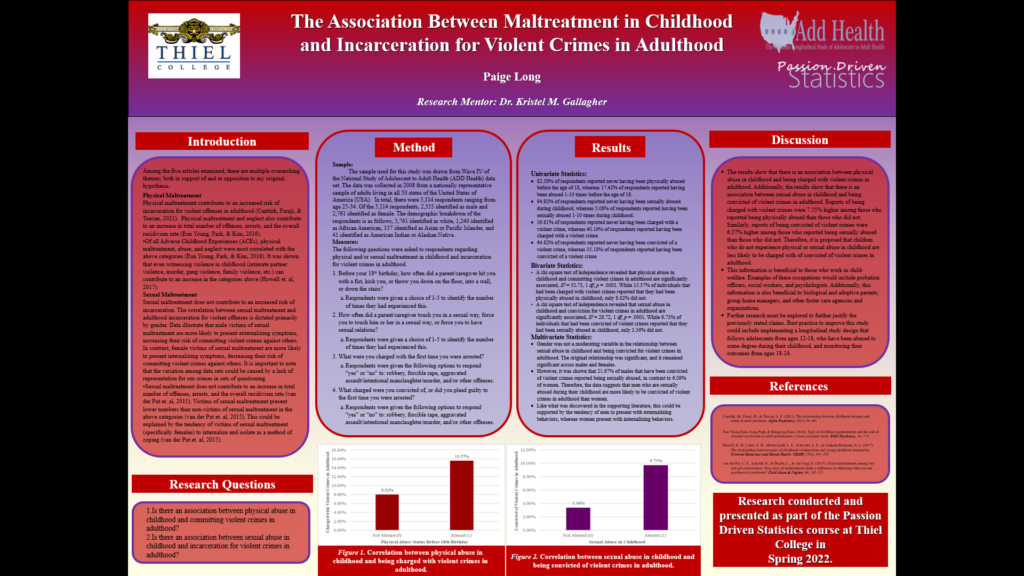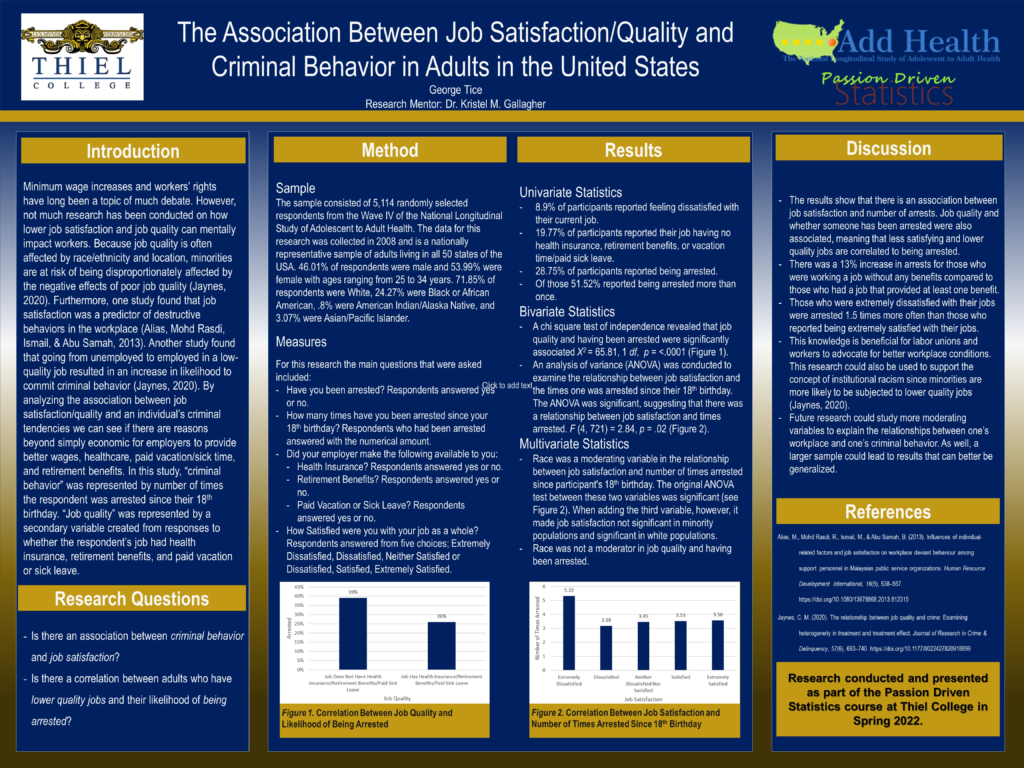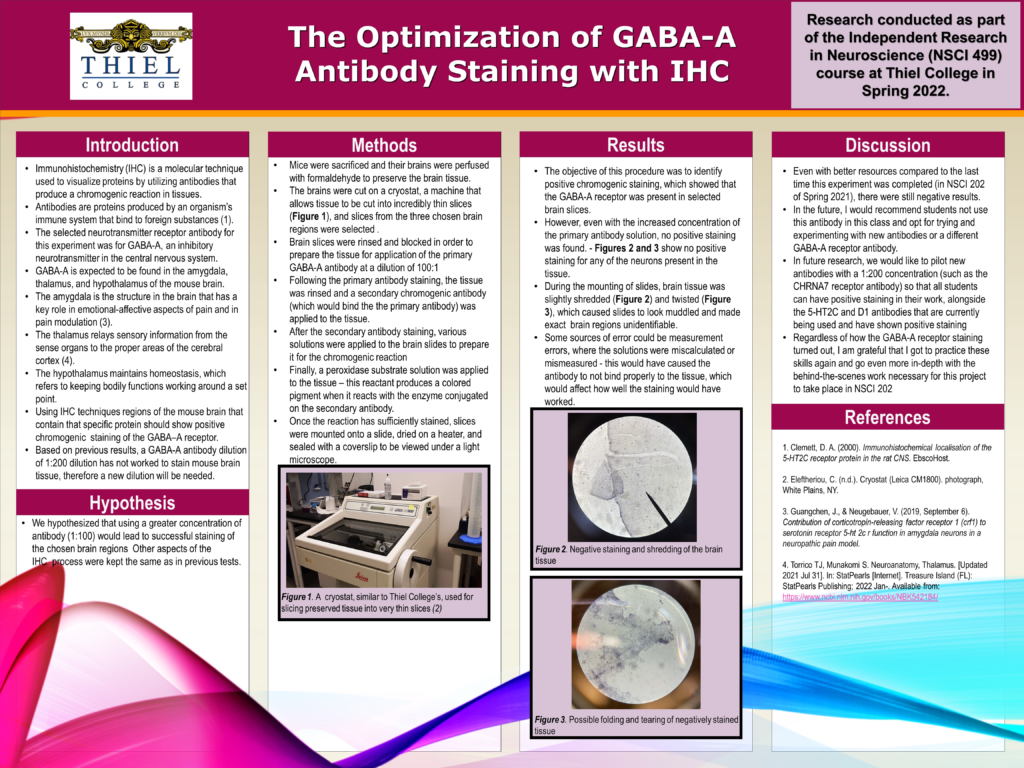Issue 2 (Fall 2022)

Editors-in-Chief
Tess Cadman and Jade Rhoads
Editorial Board
Matt Beuermann, Emily Irons, Janelle Mudry, Samantha Reid, Virginia Riddle, Hannah Stoughton, Madeleine White, and Morgan Wood
Faculty Advisor
Dr. Sheila Gross
Dietrich Honors Institute Director: Dr. Sheila Norwinski
Issue 2 Journal Articles
“But I Love That Book!”: Banned Literature and its Implications
By Tess Cadman
A Tale as Old As Time: The Evolution of Love in Beauty and The Beast
By C. Grace Honeycutt
Are Students at Thiel College Getting Enough Physical Activity?
By Alexander Lutz
Evolutionary Horror: The Shift of Gothic Literature Away from Classic Tropes
By Bradley Molnar
Beauty and the Beastly Bisexual: A Comparative Investigation of Queer Narratives and Human-Monster Relationships in Fiction
By Janelle Mudry
Enhancing Student Engagement: Graphic Novels in the High School English Curriculum
By Samantha Reid
Issue 2 Research Posters
The Association Between Maltreatment in Childhood and Incarceration for Violent Crimes in Adulthood
By Paige Long
Abstract
The purpose of this study was to examine the relationship between childhood maltreatment and violent criminal behavior in adulthood. In this study, maltreatment was defined using physical and sexual abuse variables. Specifically, I examined the age of first abuse experience and frequency of abuse thereafter. Furthermore, violent criminal behavior was defined using variables related to criminal history. Specifically, I examined age of first arrest (pre respondents’ 18th birthday), frequency of arrests thereafter (post respondents’ 18th birthday), charge/conviction history (forcible rape, robbery, aggravated assault, manslaughter, and/or murder), and years spent incarcerated (across the life course). The results of this study depicted a significant, positive correlation between maltreatment in childhood and incarceration for violent crimes in adulthood.
The sample was obtained through Wave IV of the Adolescent to Adult Health (ADD Health) Data Set. In total, there were 5,114 respondents aged 25-34. Of the respondents, 2,353 identified as male and 2,761 identified as female, with varying racial identities. Responses were measured using a self-report questionnaire method. Data was analyzed using a Chi-Square Test of Independence, which revealed that individuals who experience physical and/or sexual abuse during childhood are more likely to be incarcerated for violent crimes in adulthood compared to those individuals who have not. Gender was examined as a moderating variable, and it did not appear to moderate the relationship. However, it did reveal important gender discrepancies that should be noted. Specifically, it was revealed that men who experience sexual abuse in childhood are three-times more likely to commit violent crimes in adulthood compared to women, thus highlighting the sociocultural trend described in the background literature, stating that men exhibit externalizing behaviors, whereas women exhibit internalizing behaviors.
Paige Long ’24 is a Cognitive and Developmental Psychology and Neuroscience major from Huntingdon, PA.

The Association Between Adult Personality Traits, Mental Health, and Parental Incarceration
By Jade Rhoads
Abstract
There has been a vast amount of research conducted in the past regarding parental incarceration and the possibility of children developing a mental health problem. This research focuses directly on parental incarceration and how this trauma directly correlates with their children’s personality traits, as well as the relationship between parental incarceration and the development of mental health problems in their children. The sample for this study was drawn from Wave IV of the National Longitudinal Study of Adolescent to Adult Health. There was a total of 5,114 respondents, ranging in ages from 25-34. This study revealed that there was a relationship between having a neurotic personality and their mother being incarcerated, as well as a correlation between being diagnosed with anxiety and having a conscientious personality. There is also a difference in results between males and females. When you look at males and females individually, the results are not significant, but then they were significant when we looked at the entire sample. Future research would need to examine the different home lives that children experience to see their personality traits differ.
Jade Rhoads ’23 is a Social Psychology and Neuroscience major from Franklin, PA.

The Association Between Job Satisfaction/Quality and Criminal Behavior in Adults in the United States
By George Tice
Abstract
This study examined two research questions. The first question was “is there an association between criminal behavior and job satisfaction?” The second question was “is there a correlation between adults who have lower quality jobs and their likelihood of being arrested?” These research questions were answered using secondary data analysis of Wave IV of the National Longitudinal Study of Adolescent to Adult Health dataset. Data was obtained from a nationally representative sample of 5,114 individuals living in all 50 US states in 2008. A self-administered survey was utilized to collect the data. The results showed that there was a significant relationship between job satisfaction and the number of times arrested since their 18th birthday, as well as between job quality and having been arrested. Further, a moderation analysis showed that race had an effect on the association between job satisfaction and number of times arrested. The results of this study suggest that lower quality and less fulfilling jobs are related to criminal behavior, but more research should be conducted to better understand these relationships. The results of this research could be used to advocate for better workplace conditions.
George Tice ’24 is a Social Psychology and Criminal Justice major from Elizabeth, NJ.

The Optimization of GABA-A antibody staining with IHC
By Morgan Wood
Abstract
Correctly using immunohistochemistry (IHC) techniques on mouse brain regions containing a specific protein should show positive staining of any neurotransmitter receptor. The selected neurotransmitter antibody for this experiment was the GABA receptor subtype A (GABA-A), an inhibitory neurotransmitter in the central nervous system. GABA’s main function is to work to block neuronal communication related to anxiety and fear. GABA-A should be found in the amygdala, thalamus, and hypothalamus of the brain. IHC, the protein visualization process used, combines anatomical, immunological, and biochemical techniques to view proteins in tissues by using specific antibodies to bind specifically to their targets in the brain.
Selected areas of the brain were thinly sliced with the help of the cryostat, washed, stained with the GABA rabbit antibody followed by an anti-rabbit biotinylated antibody dilution, and were observed for a reaction using the chromogenic technique to visualize where the protein was present. The slices were then mounted so that the results could be easily observed. The objective of these procedures was to identify positive staining in the regions that the GABA-A was present in the slices we collected in the earlier stages of the research. Previous research of this antibody at Thiel College showed unsuccessful staining of GABA-A at the 1:200 dilution level in similar brain regions, so this research tested a more concentrated GABA-A formula.
The hypothesis was that a 1:100 dilution of the GABA-A antibody would produce positive staining in the previously mentioned regions. The results for this experiment supported a null hypothesis and provided no positively stained regions of a mouse brain, showing that the GABA-A antibody used in the Introduction to Neuroscience class is most likely ineffective.
Morgan Wood ’23 is a Neuroscience major from Fredericksburg, VA.

